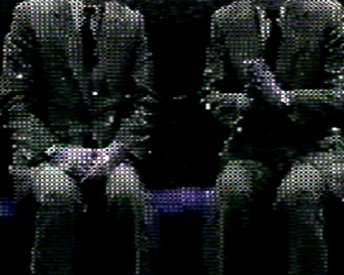Double Trouble (1986), 5:23 mins, Tokyo.
One of the earliest works made by Callas using a Fairlight Computer Video Instrument (CVI) processor, a pioneering compositing and special effects system he utilised regularly from the mid 1980s to early 90s. The CVI was a hybrid of video and computing technologies which enabled low resolution computer-like effects to be produced ‘live’ without any rendering. Double Trouble is the first video made by Callas for a large-screen format, and also his first made for the exterior street screen (in Japan).
The image appears as though spliced into vertical halves, an array of imagery and characters appearing in double on either side of the division, and moving with alternating motion upwards and downwards. This two-frame animation technique creates two images from one checkerboard stencil which are then reversed, or asynchronously ‘mirrored’. Subtle differences, however, form an apt metaphor for cultural differences in ‘body language’ between East and West.1
- 1. Rachel Kent from “Peter Callas: Initialising History, video works 1980-1999”





